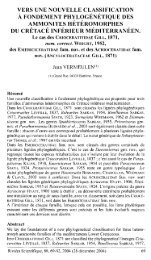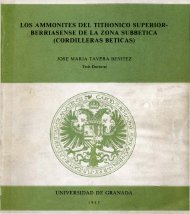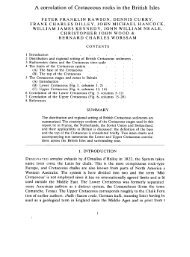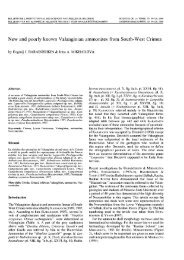thiolliericrinid crinoids from the lower cretaceous of crimea
thiolliericrinid crinoids from the lower cretaceous of crimea
thiolliericrinid crinoids from the lower cretaceous of crimea
You also want an ePaper? Increase the reach of your titles
YUMPU automatically turns print PDFs into web optimized ePapers that Google loves.
— 657 —occupying nearly <strong>the</strong> whole centrodorsal surface in<strong>the</strong> oldest specimens. The stem facet, being flat in <strong>the</strong>young specimens, turned into concave in <strong>the</strong> adultones.The centrodorsal grew quicker than <strong>the</strong> radiais inH. heberti (fig. 17C). Therefore, <strong>the</strong> upper centrodorsalsurface is very concave. The basais, being visible in<strong>the</strong> young specimens, disappeared in <strong>the</strong> adult ones.The height <strong>of</strong> <strong>the</strong> radiais decreased. The diameter <strong>of</strong><strong>the</strong> centrodorsal was roughly equal to that <strong>of</strong> <strong>the</strong>radial ring in <strong>the</strong> young specimens. However, <strong>the</strong> centrodorsalwas considerably wider than <strong>the</strong> radiais in<strong>the</strong> adult specimens. The stem facet was almostalways flat.7 — ORIGIN OF THE THIOLLIERICRINIDAEMany <strong>thiolliericrinid</strong>s have <strong>the</strong> quite developed cirriwith <strong>the</strong> mobil bifascial articulation <strong>of</strong> cirrals on <strong>the</strong>ircentrodorsals. Only Comatulida and Pentacrinida *may have such cirrus construction among postpaleozoic<strong>crinoids</strong>. So specialized cirral organs couldnot originated twice in <strong>the</strong> phylogeny <strong>of</strong> <strong>crinoids</strong>.Therefore, <strong>the</strong> origin <strong>of</strong> Thiolliericrinidae must beconsider in <strong>the</strong> close connection with <strong>the</strong> origin <strong>of</strong>comatulids and pentacrinids in one phylogeneticsequence with <strong>the</strong>se groups.Three hypo<strong>the</strong>sis are possible in <strong>the</strong> comprehension<strong>of</strong> <strong>the</strong> development <strong>of</strong> three given groups, namely :(1) stalked pentacrinids, (2) stalked <strong>thiolliericrinid</strong>s or(3) stemless comatulids are initial. The embryologicalinvestigations showed that young stages <strong>of</strong> comatulidswere stalked (Thomson 1865 ; A .H . Clark 1921). Thefine and peculiarly constructed perforation on <strong>the</strong><strong>lower</strong> centrodorsal face <strong>of</strong> some (relatively primitive?) comatulids (A.M. Clark 1973, fig. 1—3) are also<strong>the</strong> illustration <strong>of</strong> <strong>the</strong> stalkness <strong>of</strong> comatulid ancestors.Available facts testify to <strong>the</strong> origin <strong>of</strong> Comatulida<strong>from</strong> stalked forms and to <strong>the</strong> unacceptability <strong>of</strong>third (see above) hypo<strong>the</strong>sis respectively.Earliest pentacrinids known beginning with earlyTriassic (Holocrinidae) had a number <strong>of</strong> specific features.One should note <strong>the</strong> following primitive signs :<strong>the</strong> distal attachement disc (replaced later into unattachedbulge), <strong>the</strong> infrabasals which can be seen on <strong>the</strong>calyx surface, <strong>the</strong> narrow spot <strong>of</strong> <strong>the</strong> crown on <strong>the</strong>radial = brachial suture. The newly-gained feature is<strong>the</strong> only one : <strong>the</strong> nodals in proximal stem part withshort cirri (mostly not more than three in a whorl).The recent Proisocrinidae are <strong>the</strong> analogue for <strong>the</strong>seancient stages. Known finds <strong>of</strong> young pentacrinids(Carpentier 1884, pi. 30a, 35, 36) and encrinids (Hagdorn1978, Abb. 21 ; 1982, Abb. 18, 19) also showthat pentacrinids have been developed <strong>from</strong> attached* Pentacrinida T o r t o n e s e (1938, p. 171, 177, 212) = IsocrinidaSie v e r t s -D o r e c k , 1952.and cirriless forms with quite large infrabasals, andthat <strong>the</strong>y had many features common with encrinids.Then, <strong>the</strong> development <strong>of</strong> pentacrinids followed apath <strong>of</strong> perfection <strong>of</strong> <strong>the</strong> cirral organs (with a mounting<strong>of</strong> <strong>the</strong> five-rayed nodal symmetry and an appearance<strong>of</strong> <strong>the</strong> cryptosymplectial sutures : Hagdorn1983, p. 357 ff.), transm utation <strong>of</strong> <strong>the</strong> calyx <strong>from</strong>dicyclic to cryptodicyclic and disappearance <strong>of</strong> <strong>the</strong>morphological isolation <strong>of</strong> <strong>the</strong> calyx <strong>from</strong> <strong>the</strong> arms.Cited data show that origin and development <strong>of</strong> <strong>the</strong>pentacrinids followed without any connection with<strong>the</strong> considerably more late Thiolliericrinidae. Consequently,only one <strong>of</strong> above mentioned hypo<strong>the</strong>sisremains acceptable : <strong>the</strong> pentacrinids are <strong>the</strong> ancestor<strong>of</strong> <strong>the</strong> cirriferous Articulata.By subsequent consideration <strong>of</strong> this hypo<strong>the</strong>sis, twoversions are possible : (1) Pentacrinida —» Thiolliericrinidae—> Comatulida (De Loriol 1880, p. 11 ; Kirk1912, p. 75 ; Jaekel 1918, p. 71 and o<strong>the</strong>rs) or (2) Pentacrinida—> Comatulida —> Thiolliericrinidae (Rasmussen1978b, p. 314 ; 1978c, p. 867, 879).One can make out two stages in <strong>the</strong> skeleton development<strong>of</strong> <strong>the</strong> recent comatulids. Deltoid plates,large basais, minute infrabasals and columnals arelaid at early cystidean stage. Absence <strong>of</strong> cirri and <strong>the</strong>construction <strong>of</strong> <strong>the</strong> calyx basis permit to see, in thisstage, an analogy with <strong>the</strong> initial forms for articulate<strong>crinoids</strong> (possibly, with Encrinidae). Fur<strong>the</strong>r, <strong>the</strong>nodal plates on which cirri can developed subsequentlyare laid under <strong>the</strong> calyx in pentacrinoid stage.We can see here <strong>the</strong> transition <strong>from</strong> Encrinidae toPentacrinida. The cirri develop on all <strong>the</strong> proximalnodals <strong>of</strong> pentacrinids. The cirri appear but only onone or two most proximal nodals <strong>of</strong> comatulids,however some discoidal cirriless columnals which arehomological to pentacrinid nodals are formed below<strong>the</strong>m. Then, <strong>the</strong> detachment <strong>of</strong> <strong>the</strong> comatulid larva<strong>from</strong> <strong>the</strong> stem takes place. By that, <strong>the</strong> free animalhad not carried yet that indivisible plate which shouldbe called as a centrodorsal. This very important circumstanceshows that <strong>the</strong> comatulid centrodorsal wasformed by some proximal nodal plates (Thomson1865, p. 536).
















